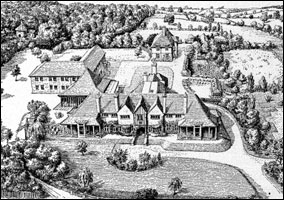![]()
The contents on this page remain on our website for informational purposes only.
Content on this page will not be reviewed or updated.
 |
|
 |
|
|
||
|
Building the 'Model Hospital'
|
||
|
||
|
NO doubt we’ve all come across some wastes of space in our time, ranging from the usual suspects of politicians and ‘managerial’ types, whose extent of self delusion greatly exceeds ability, to that other perennial favourite the ‘consultant.’
And a quick glance through the ‘sits vac’ of the local press confirms that the gravy train is still firmly on the tracks, for in the local health service we appear to have a need for ‘Non Executive Directors.’ But then who is going to apply at only £12,000 for up to four days per month? And surely that can’t be four full days; the little lambs would freak out with stress. Still, they’ll have plenty of time to chill, by helping out on the wards. But in the days before state funding there was little money around, and the poor had little recourse to any sort of medical treatment. In fact even at the turn of the 20th century hospitals in Britain were only supported by voluntary contributions, endowments, and patients’ payments, and in many towns ‘Hospital Week’ was an annual feature to raise money for the purpose. But the district of Woburn was more fortunate, for Mary, the wife of the 11th Duke of Bedford, not only set up her own cottage hospital but devoted herself to the actual nursing. It had been in India during his service as aide-de-camp to the Viceroy that she had first made the acquaintance of her future husband, and after their marriage in 1888 on their return to England she set up a cottage hospital in Woburn. Indeed, such was her devotion that by taking a course of lectures at London Hospital she would qualify as a nurse and operations sister, and later even acquire the skills of a radiologist and radiographer. Then as a replacement for her earlier centre, during 1902-3 she had a ‘model hospital’ built to her own design, which, with accommodation for 14 patients, would be subsequently run by her private physician Dr Glendining, who, having purchased the property in 1903, she installed at ‘Woodcote’, at Aspley Guise. With the outbreak of World War One the facility became a military hospital – as also the converted Riding School and indoor tennis court at Woburn Abbey did – and in tending the casualties Mary would regularly work 16 hours a day. In 1917 the hospital was then designated as a special surgical military hospital, and to here in a fleet of ambulances the wounded would be brought from the ambulance trains arriving at Bletchley station, direct from France. Some 2,453 NCOs and men were destined to pass through the Woburn facility, and in due course the Duchess would erect a plaque in the local church to commemorate the 60 NCOs and men who, between 1914 and 1920, died at the hospital. Also commemorated would be Johannes Zacherias Truter FRCS of Wellington, South Africa, who until his death on December 15, 1918 had been the assistant surgeon at the hospital. Apart from nursing, the Duchess also developed a passion for flying, but on a flight from her airstrip at Woburn she went missing in 1937, and parts of the wreckage would later be washed up at Yarmouth. Following her death the Woburn hospital closed, and during World War Two became a printing centre for propaganda literature. After the war, the premises, known as Maryland, became a hostel for Cranfield College, and then in more recent years an adult education centre. However, this recently closed and the building is now being converted into apartments But back to perusing the ‘sits vac,’ and as one who can only forlornly gaze at the heights of ‘Non Executive Director,’ on the same page my attention was drawn to becoming an extra in ‘Adult films,’ which one naturally assumed to be some part in a gardening or home cooking documentary. So imagine the fit of the vapours when informed au contraire. Oh well, back to the day job, for it seems both careers are best avoided, unless you’re happy to display more than seems decent of bare faced cheek. |
||
|
|
||
|
|
||

